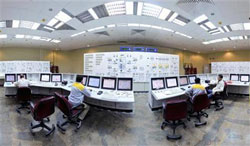 Reuters: Iran could make a nuclear weapon in as little as one or two years if it wished, an influential think-tank said on Thursday — but industrial sabotage and the Stuxnet computer worm had probably slowed its progress.
Reuters: Iran could make a nuclear weapon in as little as one or two years if it wished, an influential think-tank said on Thursday — but industrial sabotage and the Stuxnet computer worm had probably slowed its progress.
By Adrian Croft and Peter Apps
 LONDON (Reuters) – Iran could make a nuclear weapon in as little as one or two years if it wished, an influential think-tank said on Thursday — but industrial sabotage and the Stuxnet computer worm had probably slowed its progress.
LONDON (Reuters) – Iran could make a nuclear weapon in as little as one or two years if it wished, an influential think-tank said on Thursday — but industrial sabotage and the Stuxnet computer worm had probably slowed its progress.
Evidence showed “beyond reasonable doubt” that Iran was seeking the capability to produce nuclear weapons should its leaders decide to go down that route, the International Institute for Strategic Studies (IISS) said in a report.
However, allegations that Iran had carried out prohibited chemical or biological weapons activities “cannot be determined from the available public information and may have been exaggerated,” the IISS said in a 128-page report on “Iran’s nuclear, chemical and biological capabilities.”
Iran is locked in a standoff with the United States and other powers over its nuclear programme, which Tehran says is peaceful but the West suspects aims to develop a nuclear bomb.
IISS said Iran’s nuclear programme looked to have been dented by the Stuxnet computer worm, widely believed to have been built by Western or Israeli experts for the purpose. Iran says the worm infected some computers at its primary nuclear plant but did not affect operations.
Western and other intelligence agencies have also been involved in a worldwide campaign to slow nuclear smuggling and make it harder for Tehran to acquire essential equipment. Some previous estimates over the last decade had suggested Iran could have a bomb by as soon as late last year.
“I think the world has been pleasantly surprised by the limitations that have been imposed on the program through industrial sabotage and the Iranians’ reliance on inefficient methods,” Mark Fitzpatrick, director of the IISS non-proliferation and disarmament programme, told Reuters.
He said so far Iran’s leaders had not gone “all out” to develop a nuclear weapon, but they clearly wanted the option to ramp up production should they make the decision to do so.
CYBER MUNITION
The United Nations Security Council has imposed four rounds of sanctions on Iran over the programme.
Estimates of when Iran might be able to produce a nuclear bomb are important because of speculation that Israel or the United States might launch military strikes to prevent it from doing so. But the head of the IISS said that missed the point.
“The diplomatic parlour game for the last couple of years has been guessing when the US or Israel might attack Iran’s nuclear program,” said IISS director-general John Chipman. “But it appears they already did but used a cyber munition with much less publicity and collateral damage.”
The London-based IISS said Iran’s current stockpile of low-enriched uranium (LEU) would, if further enriched, be enough for one or two nuclear weapons. But it said Tehran would need more than one form for a credible nuclear deterrent.
If the 4,000 centrifuges that appeared to be working well at Iran’s Natanz enrichment plant were used for weapons purposes, and they continued to perform at their maximum output to date, “a little over a year and seven months would be required for the first bomb’s worth of HEU (highly enriched uranium),” it said.
This assumed Iran would use a four-stage production method developed by Pakistan and sold by Pakistani nuclear scientist A.Q. Khan on the black market, it said. Khan confessed to selling nuclear secrets to Iran, North Korea and Libya in 2004.
In theory, a quicker method, called a batch enrichment process, could be used, allowing the first weapon’s worth of HEU to be produced in six months and sufficient quantities to make subsequent bombs in four months. But this was untested and was therefore less likely to be used, it said.
Whichever method was used, at least six more months would be required to convert the HEU from gas form into metal and fashion it into a weapon, the report said.
“The minimum timeline then for the first weapon is over two years under the Pakistan method and one year for the batch method,” the report said. Developing a means to deliver a nuclear weapon — a missile — added to the timeline, it said.
(Editing by Keith Weir)


